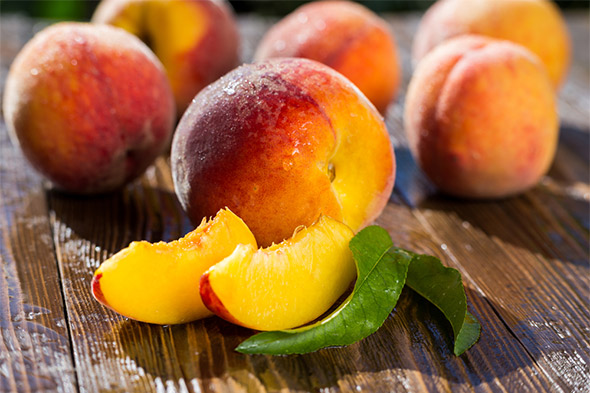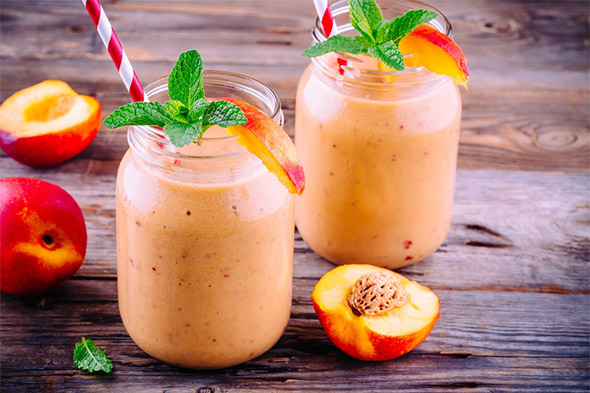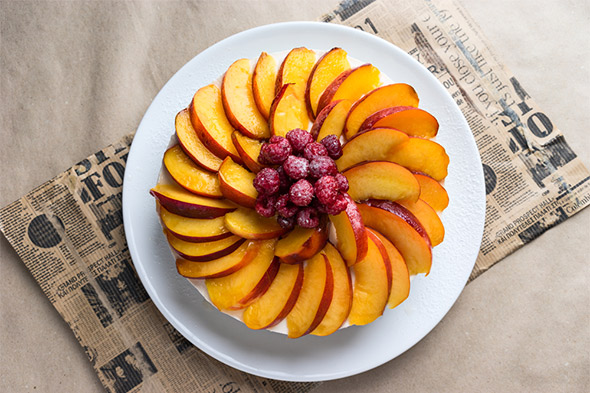
The Great Stone-Fruit War
Peaches and nectarines are, for many, the peak of summer fruit. Sweet, juicy, and delicious, this duo of nature’s bounty – so similar, yet so different – is completely irresistible. Both peaches and nectarines are considered stone fruit —fruit that has a hard, large pit (the stone) surrounded by sweet flesh. Learn more about peaches and nectarines now – moments before they hit the fruit stands.
Peaches vs Nectarines
Nectarines and peaches are basically the same, except for the fuzz, or lack thereof. Contrary to popular belief, nectarines are not a cross between a peach and a plum. Typically, nectarines are smaller and firmer than peaches, but both have either yellow or white flesh on the inside. So while they might look slightly different on the outside, their insides are very much alike. Their genetics are nearly identical as well – aside from a recessive gene in nectarines that gives them their smooth skin, versus the peaches’ fuzzy skin.
Peaches, nectarines, plums, apricots, and cherries – all stone fruits – are in the genus Prunus, which belongs to the Rosaceae (rose) family. Other fruits that are not stone fruit are also members of the rose family, such as strawberries, apples, and pears, and “cane” fruits like blackberries and raspberries.
Another stone fruit – and a close relative of peaches, plums, and cherries – is the almond (Prunus dulcis). Almond shells resemble peach pits, and when almonds are on the tree, they are similar to small, hard, green peaches. Another sign of their relationship is that the seeds inside a peach pit look very much like almonds and taste somewhat like them, too. However peach pits are not a substitute for almonds due to their stronger flavor and their potential toxicity.
History of Peaches and Nectarines
Peaches date back to at least the 10th century in China. Considered a favorite among Chinese emperors, peaches were later introduced to the Romans by the Persians, and they were brought to Europe by Alexander the Great. Spanish explorers brought peaches to South America, and, in the early 17th century, English horticulturalist George Minifie brought peaches to the New World, where he planted seeds at his Virginia estate. Subsequently, Native American tribes spread peach seeds across the United States, planting them as they traveled. Commercial peach production in the United States began in the 19th century, and now they are commercially grown in California, Washington, South Carolina, Georgia and Missouri.
Like peaches, nectarines originated in China over 2,000 years ago and were later cultivated in Persia and Rome. Nectarine literally means “sweet as nectar,” and in China they were thought of as the nectar of the gods. Farmers in England grew nectarines in the 1600s, and Spanish explorers later introduced nectarines to the United States. Today, over 95% of the nectarines produced in the United States are grown in California.
Types of Peaches and Nectarines
Peaches and nectarines both come in either freestone varieties, where the flesh inside separates easily from the pit, or as clingstones, where the flesh does not separate. It’s not easy to tell which is which, but, as a general rule, clingstone fruit usually arrives first to the farmer’s market followed by freestone. The flavor is basically the same, but this difference will impact how you pit them.

Freestone fruits are better for freezing, whereas clingstone are better for canning. In addition, because freestone peaches are sturdier, they are better for the grill (a lightly browned peach half is an excellent side dish). Cling peaches have a softer and more succulent texture, making them a great choice for pies, jams, cobblers and crisps.
Peaches and nectarines also come in yellow- and white-fleshed varieties. Yellow-fleshed fruits are usually juicier and more fragrant; on the other hand white-fleshed fruits are less acidic and therefore sweeter. White-fleshed peaches also bruise more easily; therefore transporting them is more of a challenge, which is sometimes reflected in their higher price.
Choosing Peaches and Nectarines
While the peach and nectarine season runs from July until September, you always want to choose fruit that looks fresh and has an attractive red “blush.” The background color should be a uniform golden, with absolutely no green tinge. Nectarine lovers say that their favorite fruit is more succulent and sweet than peaches, but it can also have a zingy aftertaste that, arguably, makes eating nectarines a more interesting and richer experience.
Smell peaches and nectarines before you buy them; if they don’t smell sweet and fragrant, they probably won’t taste sweet and fragrant. Choose firm fruit (not too hard or too soft) that is fragrant at the stem, and that has smooth (well, fuzzy, when it comes to peaches), unblemished skin.
Peaches are best ripened at room temperature. Do not refrigerate fruit before they are ripe as it will dry the fruit out and can result in a mealy texture. Ripe fruit can be stored in the refrigerator for up to two days. Ripe peaches and nectarines should be soft but not mushy in any way. White-fleshed varieties can be firmer because the sugar content is higher. If you do buy under-ripe hard peaches or nectarines, you can soften them by sealing them in a bag with a banana or an apple for a day or two at room temperature. The banana or apple gives off ethylene, a gas that helps to ripen stone fruits.
When cooking, peaches and nectarines are more or less interchangeable, and you can freely substitute one for the other. So if you bake one type into a cobbler, or grill one type for a BBQ, you can expect similar results.
Health Benefits of Peaches and Nectarines
In terms of nutritional value, both peaches and nectarines are excellent choices. At roughly 70 calories, a large peach contains fiber, antioxidants (to help prevent chronic diseases and reduce inflammation), potassium, Vitamin C, and Vitamin A. A medium-sized nectarine has about 60 calories, and contains large amounts of beta-carotene for vision, potassium, and lutein, which helps to support healthy eyes and skin as well as decrease the risk of cancer.
Nectarines and peaches are very low in saturated fat, cholesterol, and sodium. A study published in the Journal of Medicinal Food in 2009 reported that there are important antioxidants in the flesh and skin of peaches, including chlorogenic acid, which helps to fight free radicals to reduce the effects of aging and deter chronic diseases. Chlorogenic acid is also believed to help fight cancer and reduce inflammation.
Baking with Peaches and Nectarines
Because peaches, nectarines, and almonds are inter-related, they are ideal when cooked together in one perfectly delicious cake:

Peach/Nectarine and Almond Cake
Ingredients
- 1 cup all-purpose flour
- 1 cup almond meal (ground almonds)
- 2 teaspoons baking powder
- 1/2 teaspoon salt
- 1/2 cup butter or margarine, softened
- 1/2 cup white sugar
- 1/4 c. brown sugar
- 3 eggs
- 1 teaspoon vanilla extract
- 1/2 cup buttermilk
- 1 1/2 lb. peaches or nectarines, peeled and sliced ½-inch thick
Directions
- Preheat oven to 350 degrees F.
- Butter and flour a 9-inch spring-form pan and set aside.
- Mix together flour, almond meal, baking powder, and salt in a small bowl and set aside.
- In the bowl of an electric mixer, beat the butter and sugar until light and fluffy, about 3 minutes. Add the eggs, one at a time, incorporating each one into the batter before adding the next.
- Alternately pour in the flour mixture and the buttermilk, starting and ending with the flour mixture.
- Spoon batter into pan and place cut fruit on top. Bake for 40-45 minutes or until a toothpick inserted in the middle comes out clean.
Enjoy Peaches and Nectarines
Regardless of where you buy your fruit – at a farmer’s market, local grocer, or a well-stocked supermarket – you’re in for a treat as summer approaches. Load up on peaches and nectarines and enjoy their great flavor and impressive health benefits. Summer isn’t summer without peaches and nectarines!